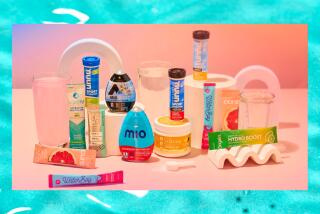Pouring On the Science
- Share via
When it comes to sports beverage marketing, it’s all a matter of dueling documents, using science to sell soft drinks.
Take PowerBurst, for example. On the right side of each colorful label is a small but oh-so-noticeable tag that says simply: “Vitafort: Balanced Nutritional Formula.”
What does that mean? While it’s hard to tell by looking at the bottle, Vitafort is a San Francisco Bay Area firm that “medically designs consumer products,” says Jeffrey Lewenthal, Vitafort president and chief executive.
“The Vitafort brand means this product has been enriched with a scientifically formulated combination of essential vitamins and nutrients,” according to PowerBurst literature. “Vitafort’s scientists have taken great care to intelligently balance this product’s nutrients to be healthier for you.”
Very official sounding, but far from original. For not only does Gatorade have a corner on the sports drink market, but it’s also had nearly a quarter of a century to perfect its research rap.
For starters, there’s the Quaker Oats Co. Exercise Physiology Laboratory in Barrington, Ill., an in-house research lab that generates studies to show that Gatorade can be absorbed into the body as well as water and is superior to its competition.
A team of Quaker Oats scientists, for example, submitted the following ponderous-sounding study to the American College of Sports Medicine’s journal: “The effects of glucose, fructose and sucrose ingestion during exercise.”
Clogged with end notes and bristling with graphs, the study basically concludes that glucose-based drinks such as Gatorade are good and fructose-based drinks such as PowerBurst are “associated with an increased incidence of gastrointestinal distress, higher ratings of perceived exertion, greater plasma volume changes, larger increases in serum cortisol and free fatty acids, and poorer exercise performance.”
And then there’s the Gatorade Sports Science Institute, two boards whose jobs it is to provide a clearinghouse for exercise science information and support the advancement of sports science research.
It also gives Gatorade an occasional boost. Take, for example, the August, 1988, volume of Sports Science Exchange, the institute’s regular publication. The topic was sports drinks, and a full-page chart comparing such beverages was topped with none other than--Gatorade.
More to Read
Eat your way across L.A.
Get our weekly Tasting Notes newsletter for reviews, news and more.
You may occasionally receive promotional content from the Los Angeles Times.







